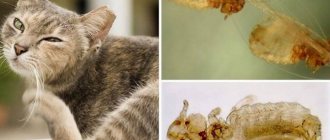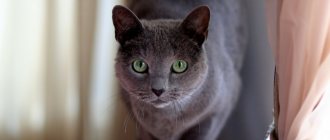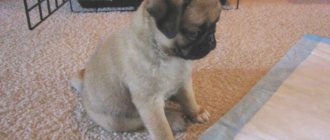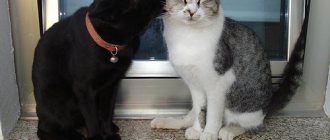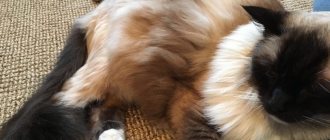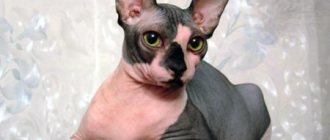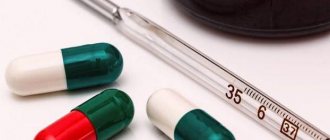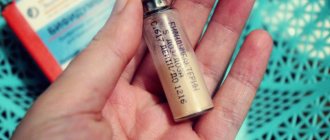Signs of pollakiuria
Depending on the reasons for the increased frequency of urination, the cat will experience various accompanying symptoms.
For example, with behavioral increase, a cat:
- makes small puddles all over the house;
- raises the tail and twitches it finely after urination.
For pollakiuria caused by diseases, the pet:
- visits his litter box more often;
- portions of urine may be small or very large (polyuria develops);
- urination is painful, the animal makes plaintive sounds when trying to urinate;
- the cat drinks more than usual;
- takes a forced pose (head tilted down, back arched, tense posture).
The general condition of the animal changes, and body temperature may increase. There is blood or sediment in the urine.
Prevention measures
Any disease can be prevented using the simplest preventive measures that are known to every experienced cat owner:
- water quality control (bottled, filtered, not raw tap water);
- reasonable physical activity - sedentary animals are more susceptible to pathologies of the urinary system;
- preventing the development of obesity;
- balanced diet enriched with nutrients;
- regular preventive examinations at the veterinarian, allowing to identify the disease at the initial stage;
- avoiding hypothermia.
To prevent diseases of the genitourinary system, it is recommended to give your cat the herbal preparation KotErvin 2 times a year.
Causes of increased frequency of urination
The mechanism of development of pollakiuria, as a rule, is based on increased sensitivity of the bladder walls. Sensitivity increases when the walls of the organ are irritated by calculi (stones), sand, chemicals, and bacteria. In cats, a physiological mechanism for excreting small portions of urine may also be involved. The reasons why this symptom may appear are different: from age-related changes to diabetes.
Age
If the animal is older, perhaps the bladder sphincter has weakened and the cat simply cannot hold urine.
Mating time
During the mating period, cats and toms can mark their territory with small portions of urine. They are characterized by behavioral changes. Cats scream loudly, calling cats. Cats become restless. Animals of both sexes mark their territory. Marks are characterized by a small amount of urine, which the owner detects not in the tray, and twitching of the tail.
Stress
If an animal is under stress for a long time, a reflex contraction of the bladder leads to increased frequency of micturition.
Hypothermia
When hypothermia occurs, the animal may urinate more frequently. Usually, when the animal warms up, this symptom goes away. But if bacterial infections develop, your cat will need medication.
Lots of liquid
Sometimes your pet gets mischievous and steals the leftover salted herring from the trash can and eats it, in which case he may drink a lot. There may be other reasons not related to illness why the animal drank too much water. Then the cat urinates frequently and profusely. This phenomenon cannot be permanent and the functioning of the excretory system quickly returns to normal.
Urolithiasis disease
If sand or stones begin to move, this leads to pain and stinging when urinating. Sand causes a large number of micro-wounds to the mucous lining of the urinary tract. Irritates the mucous membrane of the bladder and leads to a reflex increase in mictions (acts of urination). There is sediment and blood in the urine. Urination is painful, urine portions are small. If stones move, this can lead to blockage of the ureter or renal colic.
Inflammation of the bladder and kidneys
A bacterial infection that affects the urethra, bladder and kidneys leads to burning, itching and frequent urine leakage in small portions. Sometimes to false urges. In this case, the animal feels acute pain at the beginning of urination and at the end. When urinating, the cat may meow pitifully. There may be blood or sediment in the urine, the urine loses its transparency and acquires a specific purulent odor. Your cat's body temperature may rise.
Tumors
Tumors can grow in the urinary system itself, and lead to narrowing of the ureters and inflammatory processes in the bladder. So in the surrounding tissues, in this case they can mechanically compress the bladder, leading to its frequent emptying.
Diabetes
This disease is characterized by thirst, drinking frequently, and passing large amounts of urine with increased frequency of urination. Increased urination leads to disruption of the water-electrolyte balance and deterioration of the cat’s condition and its appearance (coat quality).
Backvaginitis in cats
This pathology is accompanied by frequent licking of the genital area, the appearance of discharge (gray, yellow and yellow-green), an unpleasant odor and frequent urination. If the discharge is not very heavy, its presence can be determined by the fact that the hair near the cat's vulva becomes wet and sticks together.
Prostatitis in cats
This disease often plagues older animals. The inflamed prostate puts pressure on the ureters and intestines. Therefore, cats often have lower back pain, the temperature may be elevated, frequent movements cause pain, and constipation bothers them.
Medicines
Taking certain medications may cause you to urinate more frequently. For example, when taking diuretins, the frequency of urination and the volume of urine increases.
Main symptoms
Signs of urinary dysfunction are visible to the naked eye: the cat pees more often than usual. If the volume of daily urine output is exceeded, then we are no longer talking about pollakiuria, but about polyuria. This can be understood by the litter in the cat's litter box.
For example, if you used to change it once a week, and recently - 2-3 times a week, it means that a serious failure has occurred in the cat’s body. For reference: the normal volume of urine excreted in an adult cat is on average 28 ml (about half a tea cup) for 2-3 visits to the litter tray per day.
Frequent urination may be accompanied by other signs - increased thirst, discharge of blood and pus along with urine, fever, weight loss. Due to frequent urination, the water-salt balance is disturbed and the appearance of the pet worsens.
The fur on the hind legs, belly, and lower part of the tail is constantly wet, emitting an unpleasant odor. For cats, which are naturally very clean animals, this causes considerable discomfort, forcing them to constantly lick themselves.
Treatment
If the increased frequency of urination is behavioral in nature, this problem will go away after castration. Increased frequency of visits to the litter box for physiological reasons does not require correction.
If your pet becomes ill, you should take it to a veterinary clinic. Eliminating a symptom without affecting the cause of the disease is problematic. For proper treatment, you need to examine the cat and determine the diagnosis. Antibiotics are used to treat bacterial infections, and antispasmodics are used to eliminate spasms of the excretory tract.
Diagnostics in a veterinary clinic
To make a correct diagnosis, a veterinarian needs to conduct the necessary diagnostic tests. After a visual examination of the animal and collection of anamnesis, the specialist prescribes for the cat:
- blood and urine tests;
- Ultrasound of the kidneys, bladder, abdominal cavity;
- radiography;
- seeding on nutrient media (in case of possible bacterial infection);
- studies on the hormonal antidiuretic complex.
We invite you to familiarize yourself with: Mini-horses - breeds and maintenance features - General information
When conducting diagnostics, the veterinarian excludes factors such as increased salt intake, medications, and infusion therapy.
What to do if your cat drinks a lot of water
To help a cat with increased thirst, you must first determine its cause: is it a natural reaction or a symptom of a disease. It may be a matter of banal over-salted food, or it may be diabetes mellitus or hepatitis. Therefore, it is very important to observe the pet’s behavior, its condition, whether there are any accompanying symptoms, deviations from the norm, changes in behavior, and so on.
If the cat is healthy, then it is worth reviewing its diet: does it have enough protein? It is also better to refuse dry food, since after it the cat is always thirsty.
If, in addition to increased thirst, the cat has any other manifestations, such as diarrhea, vomiting, or a passive state, then you need to sound the alarm and call a veterinarian at home.
By seeking help from a veterinarian who will prescribe the appropriate treatment for your cat, try to provide your pet with the necessary care and attention. Always leave him a bowl of clean water. Follow the course of treatment strictly and follow all the veterinarian’s recommendations.
Why does a cat drink a lot often?
Such a phenomenon as polydipsia, or increased thirst, is rare. It’s one thing - zealous owners often overestimate this phenomenon, believing that their pet turns to water too often. It is considered normal if a cat weighs 3 kilograms and drinks 200-300 grams of water per day, that is, 70-100 grams per kilogram of body. If, at this weight, she drinks 400-500 grams of water, then you can worry - the pet clearly has increased thirst.
What are the causes of increased thirst in a cat? There are several of them. This:
- transferring your pet from liquid to dry food. The water content in dry food is only 10-15%. It is clear that with this coefficient the cat will want to drink after every meal.
- a change in living conditions: an animal, for example, from a forest-steppe zone for some reason found itself in a sultry desert - naturally, it will immediately want to drink;
- pregnancy;
- exercise stress;
- hot season;
- stuffy room, lack of ventilation;
- consumption of certain foods. For example, rice has a strong diuretic effect, thus, consuming it, the cat goes to the toilet more often and, accordingly, drinks more often;
- large amounts of salt in food. It is known that after eating salty foods, natural thirst begins;
- lack of protein in your pet’s diet;
- reaction to medications, chemotherapy, etc.
It is considered normal if a cat weighs 3 kilograms and drinks 200-300 grams of water per day, that is, 70-100 grams per kilogram of body. If, at this weight, she drinks 400-500 grams of water, then you can worry - the pet clearly has increased thirst.
These are all reasons that cause increased thirst not as a pathology, but as a natural reaction. If the cat has prerequisites for the listed phenomena, then in this case there is no need to worry. Change the diet or ventilate the room - then the cat will drink less often.
As for polydipsia as a pathology, you will need the help of a doctor - you need to call him at home. If there are no obvious reasons for increased thirst, then perhaps the pet is sick or has experienced stress, which is also typical for polydipsia. Only an experienced veterinarian can understand polydipsia in a cat as a pathology.
The causes of polydipsia as a manifestation of a disease can be:
- accumulation of fluid or pus in the body cavity;
- dropsy;
- evaporation of fluid from the surface of the skin along with a wound or burn;
- diarrhea;
- vomit;
- discharge from the genitals;
- food poisoning;
- blood loss.
If there are no obvious reasons for increased thirst, then perhaps the pet is sick or has experienced stress, which is also typical for polydipsia. Only an experienced veterinarian can understand polydipsia in a cat as a pathology.
In addition, taking certain medications can cause extreme thirst in a cat, such as:
- diuretics;
- hormonal drugs;
- anticonvulsants.
A protein diet also causes increased thirst in cats.

